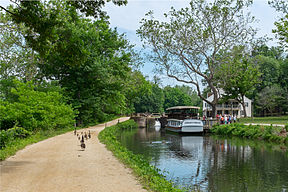Chesapeake & Ohio Canal
| Chesapeake and Ohio Canal | |
|---|---|

The Chesapeake and Ohio Canal at Lock 20
|
|
| Specifications | |
| Length | 184.5 miles (296.9 km) |
| Maximum boat length | 90 ft 0 in (27.43 m) |
| Maximum boat beam | 14 ft 6 in (4.42 m) |
| Locks | 74 (Boats must pass guard locks 4 & 5 for each trip.) |
| Status | National Park |
| History | |
| Original owner | Chesapeake and Ohio Canal Company |
| Principal engineer | Benjamin Wright |
| Other engineer(s) | Charles B. Fisk, William Rich Hutton |
| Date of act | 1825 |
| Construction began | 1828 |
| Date of first use | 1830 |
| Date completed | 1850 |
| Date closed | 1924 |
| Geography | |
| Start point | Georgetown, Washington DC (originally Little Falls, MD) (Canal extended down to Georgetown in 1830) |
| End point | Cumberland, MD (originally Sections to Pittsburgh, PA never built) |
| Connects to | Alexandria Canal (Virginia), Goose Creek & Little River Navigation |
The Chesapeake and Ohio Canal, abbreviated as the C&O Canal and occasionally called the "Grand Old Ditch," operated from 1831 until 1924 along the Potomac River from Washington, D.C., to Cumberland, Maryland. The canal's principal cargo was coal from the Allegheny Mountains.
Construction on the 184.5-mile (296.9 km) canal began in 1828 and ended in 1850 with the completion of a 50-mile stretch to Cumberland. Rising and falling over an elevation change of 605 feet (184 meters), it required the construction of 74 canal locks, 11 aqueducts to cross major streams, more than 240 culverts to cross smaller streams, and the 3,118 ft (950 m) Paw Paw Tunnel. A planned section to the Ohio River at Pittsburgh was never built.
The canal way is now maintained as the Chesapeake and Ohio Canal National Historical Park, with a trail that follows the old towpath.
After the American Revolutionary War, George Washington was the chief advocate of using waterways to connect the Eastern Seaboard to the Great Lakes and the Ohio River. In 1785, Washington founded the Potowmack Company to improve the navigability of the Potomac River. His company built five skirting canals around the major falls: Little Falls (later incorporated in the C&O Canal), Great Falls in Virginia, Seneca Falls (opposite Violette's lock), Payne's Falls of the Shenendoah, and House's Falls near Harpers Ferry. These canals allowed an easy downstream float; upstream journeys, propelled by pole, were harder.
...
Wikipedia
